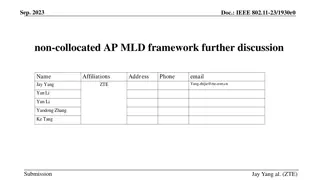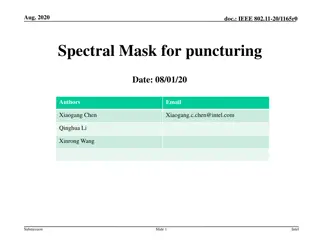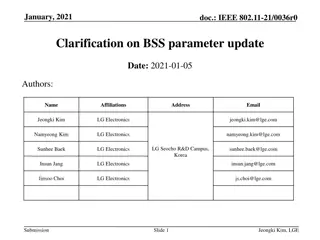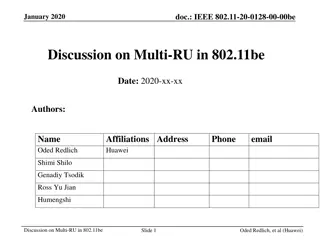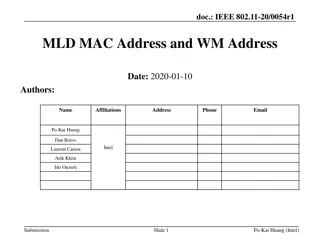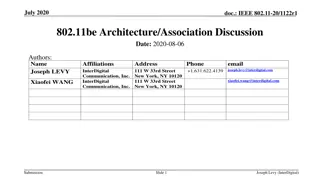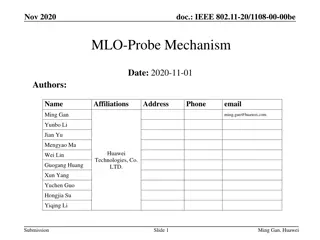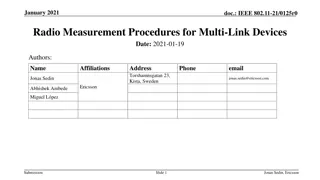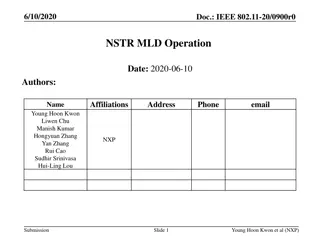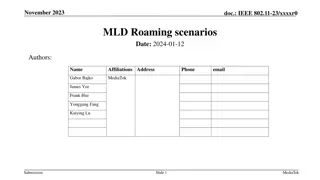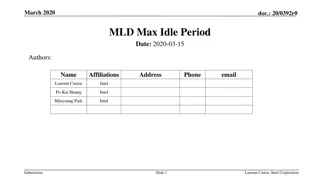IEEE 802.11be MLD Architecture Discussion
This presentation delves into architecture concepts for TGbe MLDs, focusing on AP and non-AP scenarios. It builds upon ideas from previous sessions, exploring topics such as RX/TX MSDU rate limiting, A-MSDU aggregation, packet integrity, and encryption. Implementation choices and legacy operation considerations are also discussed.
Download Presentation

Please find below an Image/Link to download the presentation.
The content on the website is provided AS IS for your information and personal use only. It may not be sold, licensed, or shared on other websites without obtaining consent from the author.If you encounter any issues during the download, it is possible that the publisher has removed the file from their server.
You are allowed to download the files provided on this website for personal or commercial use, subject to the condition that they are used lawfully. All files are the property of their respective owners.
The content on the website is provided AS IS for your information and personal use only. It may not be sold, licensed, or shared on other websites without obtaining consent from the author.
E N D
Presentation Transcript
March 2021 doc.: IEEE 11-21/0396r0 802.11be MLD Architecture Discussion Date: 2021-03-07 Authors: Name Mark Hamilton Affiliations Address Ruckus/CommS cope Phone +1-303-818-8472 email mark.hamilton@commsco pe.com 350 W. Java Dr Sunnyvale, CA 94089 Sli de 1 Submission Slide 1 Mark Hamilton, Ruckus/CommScope
March 2021 doc.: IEEE 11-21/0396r0 Abstract This presentation considers architecture concepts for TGbe MLDs, AP and non-AP. This is follow-on from ideas in 11-20/1639, and starts from assumptions/agreements from ARC sessions from Nov 20 through Feb 21, in that document. Sli de 2 Submission Slide 2 Mark Hamilton, Ruckus/CommScope
March 2021 doc.: IEEE 11-21/0396r0 (U) (C) IEEE 802.1X Controlled and Uncontrolled Port Filtering (optional) (M) MLD data plane agreed model RX/TX MSDU Rate Limiting A-MSDU Aggregation (TX) / De-aggregation (RX) PS Defer Queuing (AP or IBSS STA only) (null) (See also, slide 9 of 11-21/0316r0) Sequence Number Assignment (null) MSDU Integrity and Protection (optional) MLD-level Fragmentation (TX) / Defragmentation (RX) Packet Number Assignment Replay Detection (optional) SYNRA Receiver Filtering (null) Block Ack Buffering and Reordering (null) MPDU Encryption (TX) / Decryption (RX) and Integrity (optional) Duplicate Detection (null) Sli de 3 Implementation choice Block Ack Scoreboarding (null) Address 1 address filtering Address 1 address filtering (null) (null) . . . MPDU Header + CRC Creation (TX) / Validation (RX) MPDU Header + CRC Creation (TX) / Validation (RX) Per-link-level A-MPDU A-MPDU Aggregation (TX) / De-aggregation (RX) Aggregation (TX) / De-aggregation (RX) Submission Slide 3 Mark Hamilton, Ruckus/CommScope
March 2021 doc.: IEEE 11-21/0396r0 AP Data plane w/legacy operation added (Alt 2 of 11-20/1639) Legacy Data frames MLO Data frames Legacy Data frames Upper legacy & group addressed MAC (legacy peer STAs and all groupcast) Upper legacy & group addressed MAC (legacy peer STAs and all groupcast) Upper MLD MAC (MLD peer STAs individually addressed) . . . Lower MAC, and PHY (MLO and legacy) Lower MAC, and PHY (MLO and legacy) Sli de 4 Link 1 BSS Link 2 BSS Mixed (MLO & legacy) Mixed (MLO & legacy) Submission Slide 4 Mark Hamilton, Ruckus/CommScope
March 2021 Reminder of (legacy) DS structure, Figure 7-1, in 802.11-2020 doc.: IEEE 11-21/0396r0 DSAF DSAF DSAF Mesh MAC PHY Portal MAC MAC MAC MAC PHY MAC DS PHY PHY PHY PHY 802.11 Medium 802.11 Medium 802.11 Medium Non-802.11 Medium Non-AP STAs AP1 Mesh Gate Portal AP2 - DS SAP Sli de 5 Submission Slide 5 Mark Hamilton, Ruckus/CommScope
March 2021 doc.: IEEE 11-21/0396r0 MLO DS structure, Alternative 3 Multi-Link Device DSAF DSAF MLD Upper DSAF Portal MAC Legacy Upper Legacy Upper DS PHY Non-802.11 Medium Lower Lower Portal Link 2 Link 1 - DS SAP - Each stack has a MAC SAP, which (on an AP) supports a DSAF, with a DS SAP MLD AP and legacy APs look like (N+1) APs to the DS The DS will route all downlink frames to the DS SAP that has registered this client (legacy non-AP STAs or MLO non-APs) Portal hides the details to the outside world Sli de 6 - - - Submission Slide 6 Mark Hamilton, Ruckus/CommScope
March 2021 doc.: IEEE 11-21/0396r0 Add (ML) management operations, and consider the stack details: Legacy Data frames MLD Data frames Legacy Data frames (U) (C) (U) (C) (U) (C) IEEE 802.1X IEEE 802.1X IEEE 802.1X Controlled and Uncontrolled Port Filtering (optional) (M) Controlled and Uncontrolled Port Filtering (optional) (M) TX Action frames Controlled and Uncontrolled Port Filtering (optional) (M) RX Action frames RX/TX MSDU Rate Limiting RX/TX MSDU Rate Limiting RX/TX MSDU Rate Limiting Beacons, Probe Req/Resp; and Control frames (RTS/CTS, Ack, NDP, etc) Beacons, Probe Req/Resp; and Control frames (RTS/CTS, Ack, NDP, etc) A-MSDU A-MSDU A-MSDU Aggregation (TX) / De-aggregation (RX) Aggregation (TX) / De-aggregation (RX) Aggregation (TX) / De-aggregation (RX) RX Assoc, etc frames TX Assoc, etc frames PS Defer Queuing (AP or IBSS STA only) PS Defer Queuing (AP or IBSS STA only) PS Defer Queuing (AP or IBSS STA only) (null) (null) (null) Sequence Number Assignment Sequence Number Assignment Sequence Number Assignment (null) (null) (null) MSDU Integrity and Protection (optional) MSDU Integrity and Protection (optional) MSDU Integrity and Protection (optional) Fragmentation (TX) / Defragmentation (RX) Fragmentation (TX) / Defragmentation (RX) Fragmentation (TX) / Defragmentation (RX) Packet Number Assignment Replay Detection (optional) Packet Number Assignment Replay Detection (optional) Packet Number Assignment Replay Detection (optional) SYNRA Receiver Filtering SYNRA Receiver Filtering SYNRA Receiver Filtering (null) (null) (null) Block Ack Buffering and Reordering Block Ack Buffering and Reordering Block Ack Buffering and Reordering (null) (null) (null) MPDU MPDU MPDU Encryption (TX) / Decryption (RX) and Integrity (optional) Encryption (TX) / Decryption (RX) and Integrity (optional) Encryption (TX) / Decryption (RX) and Integrity (optional) (null) Duplicate Detection (null) Duplicate Detection (null) Duplicate Detection Block Ack Scoreboarding Block Ack Scoreboarding Block Ack Scoreboarding (null) (null) (null) Address 1 address filtering Address 1 address filtering (null) (null) . . . . . Sli de 7 MPDU Header + CRC Creation (TX) / Validation (RX) MPDU Header + CRC Creation (TX) / Validation (RX) A-MPDU A-MPDU Aggregation (TX) / De-aggregation (RX) Aggregation (TX) / De-aggregation (RX) Physical Layer Physical Layer Link 1 BSS Link 2 BSS Mixed (MLO & legacy) Mixed (MLO & legacy) Submission Slide 7 Mark Hamilton, Ruckus/CommScope
March 2021 doc.: IEEE 11-21/0396r0 To add management concepts, we have this figure as the fundamental reference model for a STA (Figure 4-24 in 802.11-2020) This adds MLME, PLME, SME concepts, and their SAPs - 802.1X Authenticator / Supplicant 802.1X MAC SAP RSNA Key Management MAC Sublayer Management Entity Data Link Layer MAC Sublayer MLME SAP MLME-PLME SAP PHY SAP Station Management Entity PHY Sublayer Management Entity Sli de 8 Physical Layer PLME SAP PHY Sublayer Do we want/need a similar reference model for MLDs? Submission Slide 8 Mark Hamilton, Ruckus/CommScope
March 2021 doc.: IEEE 11-21/0396r0 For Multi-band capable devices (FST from 11ad), we added Figure 4-28 in 802.11-2020: 802.1X Multi-band Management Authenticator / Supplicant RSNA Key Management 802.1X MAC SAP Transparent FST Entity MAC Sublayer Management Entity MAC Sublayer Management Entity MAC Sublayer MAC Sublayer PHY SAP PHY SAP MLME-PLME SAP MLME-PLME SAP PHY Management Entity PHY Management Entity PHY PHY SME SME STA 1 STA 2 (e.g., in 2.4 GHz) (e.g., in 60 GHz) Suggest this was a bad idea raises many questions about what is this part ? Why isn t the MAC SAP at the top? Are there always exactly two STAs, Etc Submission Slide 9 Mark Hamilton, Ruckus/CommScope
March 2021 doc.: IEEE 11-21/0396r0 Is this any better (or is it worse)? (U) (C) 802.1X MAC SAP (U) (C) (U) (C) 802.1X MAC SAP 802.1X MAC SAP Legacy upper MAC Legacy Upper MLME (U) (C) 802.1X MAC SAP Legacy Upper MLME Legacy upper MAC 802.1X Authenticator / Supplicant MLD Upper MAC MLD Upper MLME Legacy upper MAC Legacy Upper MLME MLME SAP MLME SAPs RSNA Key Management SME (MLD aware) Lower MAC Lower MLME Lower MAC Lower MLME Lower MAC PHY SAP Lower MLME MLME SAPs PLME PHY SAP PHY PHY SAP PLME PHY PLME SAPs PLME PHY Sli de 10 (N) Channels or bands Other suggestions? Submission Slide 10 Mark Hamilton, Ruckus/CommScope
March 2021 doc.: IEEE 11-21/0396r0 What about non-AP? Non-AP is always either MLO or legacy So, no combined view. It s either one or the other: Upper MLD MAC Upper MLD MAC Sli de 11 . . . Lower MAC, and PHY Lower MAC, and PHY Lower MAC, and PHY Submission Slide 11 Mark Hamilton, Ruckus/CommScope
March 2021 Analysis of stack details what is where? doc.: IEEE 11-21/0396r0 Alternative 2 Security SAs/Keys (In MLO, agreement, there is 1 PTK/PMK per MLD- MLD (P2P) association , managed by MLD stack) (GTKs are distributed via MLD-MLD association) PTK/PMK: - MLO: PTK/PMK in MLD stack; - Legacy: legacy stack s PTK/PMK; GTK, IGTK, BIGTK: in each legacy stack (Re)(Dis)Association, (De)Authentication AP: Routing RX d to which stack is based on ML element indication (legacy or MLO) Authenticator(s) 1 per legacy + 1 for MLD (At least separate Authenticator IDs (AAs)) Sli de 12 Submission Slide 12 Mark Hamilton, Ruckus/CommScope
March 2021 Analysis of alternatives what is where; what is different? Alternative 2 doc.: IEEE 11-21/0396r0 Address1 filter/RX frame routing The value of the RA/TA fields sent over- the-air in the MAC header of a frame is the MAC address of the STA affiliated with the MLD corresponding to that link. [Motion 108, [30] and [186]] MLD Peer -> MLD Legacy Peer -> Legacy stack (All RX d frames, data, Auth/Assoc, Mgmt, etc.) Except: - Power Save affecting information: PM bit, PS-Poll frames, PS trigger frames handled by Lower MAC. - MLD knows when all links (or all relevant-TID links) are doze (PS mode??), and buffers SAP(s) AP: 1 MLD, 1 per legacy guarantees frame order w/in TS (DS is responsible for routing DL) Non-AP: Consistent MAC address (MLD or legacy) Sli de 13 Submission Slide 13 Mark Hamilton, Ruckus/CommScope
March 2021 Analysis of alternatives what is where; what is different? doc.: IEEE 11-21/0396r0 Alternative 2 Beacons; Probes All go to legacy stack TIM bits? Robust management frames GAS/ANQP (Pre-Assoc or post-Assoc) ?? QoS queues/retry buffers (includes how to merge TX traffic at the lower MAC boundary) Two sets? (With normal co-located BSS contention between them?) Block Ack ?? MLO channel configuration/modification of operation Sli de 14 Submission Slide 14 Mark Hamilton, Ruckus/CommScope
March 2021 Analysis of alternatives what is where; what is different? doc.: IEEE 11-21/0396r0 Alternative 2 SN and PN (including QMF) Number spaces per stack need MLO RXr to keep separate DMS Legacy peer: as today; MLO peer: messy Multiple BSSID sets Are legacy and MLD stacks separate multiple BSSs ? Any impacts on DS interface? Separate SAPs so what (??) What is an ESS/BSS? (In MLO, transitions to/from MLO) Access Controls? Sli de 15 Multi-AP coordination? (Mixed-mode) Mesh? Relays? OCB? TDLS? Submission Slide 15 Mark Hamilton, Ruckus/CommScope



